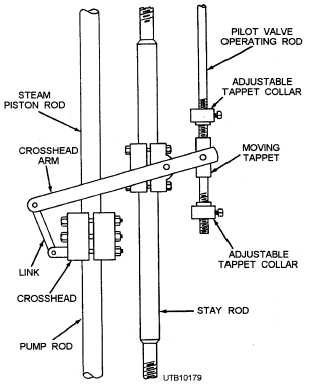The pump shown in figure 6-12 is designed to operate with a discharge pressure higher than the pressure of the steam operating the piston in the steam cylinder; in other words, it is a high-pressure pump. In a high-pressure pump, the steam piston is larger in diameter than the plunger in the liquid cylinder. Since the area of the steam piston is greater than the area of the plunger in the liquid cylinder, the total force exerted by the steam against the steam piston is concentrated on a smaller working area of the plunger in the liquid cylinder. Because of this factor, the pressure per square inch is greater in the liquid cylinder than in the steam cylinder. A high-pressure pump discharges a comparatively small volume of liquid against high pressure. A low-pressure pump, on the other hand, has a comparatively low discharge pressure but a larger volume of discharge. In a low- pressure pump, the steam piston is smaller than the plunger in the liquid cylinder.
Finally, the pump shown in figure 6-12 is classified as vertical because the steam piston and the pump plunger move up and down. Most reciprocating pumps in naval use are vertical; however, you may occasionally encounter a horizontal pump where the piston moves back and forth instead of up and down.
OPERATION AND MAINTENANCE OF RECIPROCATING PUMPS. - The power end of a reciprocating pump consists of a bored cylinder in which the steam piston reciprocates. The steam cylinder is fitted with heads at each end; one head has an opening to accommodate the piston rod. Steam inlet and exhaust ports connect each end of the steam cylinder with the steam chest. Drain valves are installed in the steam cylinder, so water, resulting from condensation, can be drained off.
The admission and release of steam to and from each end of the steam cylinder are automatically timed by a valve operating assembly (fig. 6-14) that connects the pilot valve operating rod and the pump rod. As the crosshead arm (sometimes called the rocker arm) is moved up and down by the movement of the pump rod, the moving tappet slides up and down on the pilot valve rod. The tappet collars are adjusted, so the pump makes the full-designed stroke.
The piston-type valve gear, commonly used for automatic timing, consists of a piston-type slide valve and a pilot slide valve. The position of the pilot slide valve is controlled by the position of the main piston in the steam cylinder. At the completion of the downstroke of the pump, the crosshead arm moves the moving tappet against the upper adjustable tappet

Figure 6-14. - Valve operating assembly for reciprocating pump.
collar to actuate the pilot slide valve that admits steam to reposition the floating piston. The movement of the floating piston opens ports to admit steam to the underside of the piston in the steam cylinder and to exhaust the steam above the piston, thus causing the piston to move upward. Once the pump has completed the upstroke, the cycle repeats itself in reverse.
Reciprocating pumps are easy to operate and usually are very reliable units; however, they require routine maintenan ce and occasional repair work. Consult the manufacturer's technical manual for details on the repair of a specific unit. Before repairing or examining a pump, assemble the pertinent blueprints, drawings, and available data. These drawings and data furnish the required clearances, tools to be used, measurements, information on materials to be used, and other important data. In addition, you should have the complete history of the pump being repaired so you know what has been done, when repairs were last made, and what kind of trouble has been encountered before with this pump.
Remember that the steam end of a reciprocating pump should NOT be dismantled until a thorough check reveals that the water end is satisfactory. Most reciprocating pump troubles result from fouled water
Continue Reading